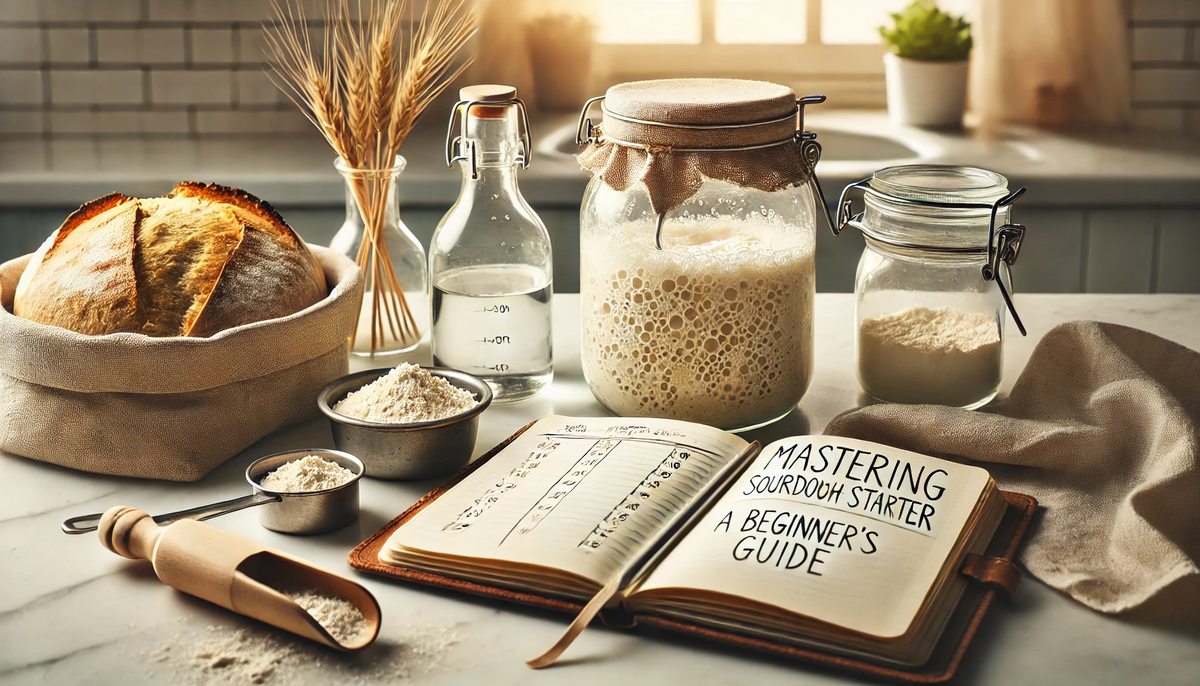
Mastering Sourdough Starter: A Beginner’s Guide
|
|
Time to read 4 min
|
|
Time to read 4 min
5 days
50 min
Sourdough
Table of content
A sourdough starter is a natural leavening agent made from a simple mixture of flour and water that has been allowed to ferment. It captures wild yeast and beneficial bacteria from the environment, which work together to help bread rise and develop its characteristic tangy flavor.
Sourdough baking is as much art as science. The method you'll read here for making sourdough starter isn't an exact match for the one you read on another site, or in a cookbook, or in your great-grandma's diary. But it's the tried-and-true method we use for making starter here at Home Bakers, and we feel you'll have success with it.
To begin your starter
To feed your starter
Combine the whole wheat flour with the cool water in your Home Bakers non-reactive Glass container.
Stir everything together thoroughly; make sure there's no dry flour anywhere. Cover loosely with the metal lid provided in the kit and let the mixture sit at warm room temperature (about 70°F / 21 C) for 24 hours.
You may see no activity at all in the first 24 hours, or you may see a bit of growth or bubbling. Either way, discard half the starter, and add to the remainder 80 grams All-Purpose Flour, and 80 grams lukewarm water.
Mix well, cover with the metal lid only, and let the mixture rest at room temperature for 24 hours.
By the third day, you'll likely see some activity — bubbling; a fresh, fruity aroma, and some evidence of expansion. It's now time to begin two feedings daily, as evenly spaced as your schedule allows. For each feeding, weigh out 80 grams starter, once it's thoroughly stirred down. Discard any remaining starter.
Add 80 grams Unbleached All-Purpose Flour, and 80 grams water to the 80 grams starter. Mix the starter, flour, and water, cover, and let the mixture rest at room temperature for approximately 12 hours before repeating.
Weigh out 80 grams starter, and discard any remaining starter. Repeat day #3.
Weigh out 80 grams starter, and discard any remaining starter. Repeat day #3. By the end of day #5, the starter should have at least doubled in volume. You'll see lots of bubbles; there may be some little "rivulets" on the surface, full of finer bubbles. Also, the starter should have a tangy aroma — pleasingly acidic, but not overpowering. If your starter hasn't risen much and isn't showing lots of bubbles, repeat discarding and feeding every 12 hours on day 6, and day 7, if necessary — as long as it takes to create a vigorous (risen, bubbly) starter.
Once the starter is ready, give it one last feeding. Discard all but 80 grams. Feed as usual. Let the starter rest at room temperature for 6 to 8 hours; it should be active, with bubbles breaking the surface.
Store this starter in the refrigerator and feed it regularly, using your normal process: Discard all but 80g starter; feed that remaining 80g starter with 80 grams flour and 80 grams water. We recommend feeding once a week, if possible. The more frequently you feed it, the less time and effort it takes to get your starter ripe and
Remove however much starter you need for your recipe — typically no more than 1 cup. If your recipe calls for more starter, give it a couple of feedings without discarding, until you've made enough for your recipe plus 80 grams to keep and feed again.
You can keep the remaining 80 grams of starter in your Home Bakers jar to store it in long-term. Feed this reserved starter 80 grams of flour and 80 grams water, and let it rest at room temperature for several hours, to get going, before covering it. If you're storing starter used the screw-top lid jar, however screw the top on loosely rather than airtight.
Feed your starter every 24/12 hours during the initial activation phase. Once established, weekly feedings are sufficient
Yes, unbleached all-purpose flour works well for feeding your starter.
Ensure it's kept at a warm room temperature (around 70°F/21°C) and feed it regularly. Patience is key.
A ready starter will double in size, show bubbles, and have a tangy aroma.
Yes, once established, store it in the refrigerator and feed it weekly.

